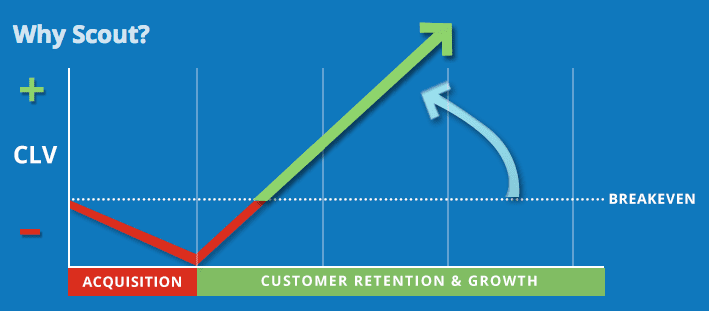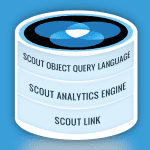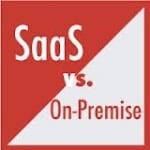 “Those who can discern the past are better able to predict the future.”
“Those who can discern the past are better able to predict the future.”
In a nutshell, that essential truth is the raison d’etre of the Issaquah-based firm known as Scout Analytics.
As specialists in the field of Predictive Analytics, Scout serves Software-as-a-Service companies and publishers of subscriber-based, news and entertainment content that are powered by recurring revenue. By applying its algorithm in concert with its clients’ usage data logs and member segmentation profiles, Scout is able to “predict the odds” of future revenue with uncanny accuracy. Will a 7 or a 14-day, free-trial result in higher conversion? What characteristic online behaviors forecast new account activation vs. a cancellation? How can you use marketing automation to optimize the outcome of every opportunity?
We peered into the predictive analytics crystal ball with Matt Shanahan, co-founder and senior vice president of marketing and strategy for Scout Analytics. In addition to his marketing prowess, Matt has a Bachelor of Science in Electrical Engineering and a Master of Science in Electrical Engineering from the University of Washington.
Seattle24x7: Matt Shanahan, welcome. Right off the top, how do you define “Predictive Analytics?”
Matt Shanahan: Predictive analytics is about determining what is most likely to happen in the future. At Scout, we focus on subscriptions. We’re predicting which customers are most likely to cancel their subscriptions and which ones are most likely to renew and/or accept a price increase. The provider is then in a position to make some decisions. If they know there’s a customer group that is going to churn or cancel, the provider can intervene and stop that. On the other hand, if the provider can’t make that prediction, they don’t know how to use their people to retain the at-risk customer group. It’s all about predicting what will happen and applying resources in order to get the outcome you want.
 Seattle24x7: Let’s look at a few examples of predictive analytics in action. What are some of the “rules of thumb” or things you have observed for recurring subscription marketers that are predictive of acquiring new business? Can you give us an example of, say, a tactical observation about who may or may not convert during a trial period based on observable behavior?
Seattle24x7: Let’s look at a few examples of predictive analytics in action. What are some of the “rules of thumb” or things you have observed for recurring subscription marketers that are predictive of acquiring new business? Can you give us an example of, say, a tactical observation about who may or may not convert during a trial period based on observable behavior?
Matt Shanahan: Sure. For instance, one general rule pertains to the first day of the trial. If the person becomes a very heavy user right off the bat they’re guaranteed not to be a long time user.
Seattle24x7: Why is that?
Matt Shanahan: Typically it’s someone just scraping an information service, just trying to steal some free data. If it’s Software as a Service they may have just wanted to get some competitive intelligence or make a quick evaluation.
Seattle24x7: What are some of the other patterns that you observe with trial users that are indicative of converting from trial?
 Matt Shanahan: In terms of trial close, someone who’s active on the last day of the trial is the most likely to sign on. The trialist is going in and trying to decide whether or not to purchase.
Matt Shanahan: In terms of trial close, someone who’s active on the last day of the trial is the most likely to sign on. The trialist is going in and trying to decide whether or not to purchase.
Seattle24x7: What about length of trial? Is there any evidence that you have found, say, for 7 days vs. 14 days, versus 30 days? What is too much time, or too little?
Matt Shanahan: What you have to look at is how many active days a user has and what is the threshold at which point they’re willing to make a decision. For example, let’s say the number of threshold usage days in a trial for a particular product is four active days, but prospects in the trial are once-a-week users, then you’d want the 30 day trial. On the other hand, if usage is intended to be daily, a week is all you need for the trial.
Seattle24x7: If you give prospective subscribers too much time, is there any way that could be a bad strategy?
Matt Shanahan: Yes, it can be a bad strategy. For instance, if you extended a typical seven day trial to two weeks, maybe the users were really active in the first week and ready to buy but then they forget about it the second week. You really want to get the conversion in the first week, because there will be a drop off.
Seattle24x7: Is that something worth testing?
Matt Shanahan: Oh, definitely. You should A/B test each of the trial parameters. If you have a hypothesis of, say, holding the trial for one week, do that for a while, and then switch to two weeks. Look at your conversion rate performance and at your volume in both cases.
Seattle24x7: So these active threshold days are very important?
 Matt Shanahan: Right, a key metric is how many active days per week do they use the service? What is the average? And how much time should they be spending? What is too low and too high? If you know those numbers, if you know exactly at what point somebody dropped off, you can set a trigger to act on that behavior.
Matt Shanahan: Right, a key metric is how many active days per week do they use the service? What is the average? And how much time should they be spending? What is too low and too high? If you know those numbers, if you know exactly at what point somebody dropped off, you can set a trigger to act on that behavior.
Setting the triggers at the right time, knowing the right things to look at, there’s where Predictive Analytics comes in. Of all the people in the last year who churned out, here are the customer segments, here’s which ones went out of business (which is an external event that cannot be controlled) versus which ones quit because they weren’t getting value and what their profile looked like.
There’s also a place to do some very targeted surveys of the people who quit and why? The people who quit after three months, or those who quit after a year, why would they quit? Then start to segment and understand why each of these people in different areas quit and what you can do to change that.
Seattle24x7: What is your feeling about “nurturing” emails? Do you work with companies that are using marketing automation?
Matt Shanahan: Absolutely, and in two different ways. One is the e-mail open and click-through data from the systems that comes into ours as part of the behavioral profile. The second thing is we do a lot of life-cycle marketing, we set “triggers” in certain campaigns to behaviorally segment customers and put them into one email track or another.
Seattle24x7: How does that work?
![]() Matt Shanahan: There’ll be a segment inside Scout, for example, “People that have a high likelihood to churn,” and we will send this information out to a system like HubSpot to run a retention campaign. One of our customers is UBM, they’re a multi-billion dollar media company. So they also hold special “events” like conferences and symposia. Based on the online reading behavior of their audience across various online publications, the analytics indicate which events to promote to the readers and even which sessions the reader should attend.
Matt Shanahan: There’ll be a segment inside Scout, for example, “People that have a high likelihood to churn,” and we will send this information out to a system like HubSpot to run a retention campaign. One of our customers is UBM, they’re a multi-billion dollar media company. So they also hold special “events” like conferences and symposia. Based on the online reading behavior of their audience across various online publications, the analytics indicate which events to promote to the readers and even which sessions the reader should attend.
What that’s done is increase the conversion rates of their customers online. So they get bigger event attendance. Every invite sent to every user is completely individualized. Every single invite is customized through to that reader’s behavior.
Seattle24x7: Your announcement on March 20, was about some new segmentation capabilities. Can you tell us about those?
Matt Shanahan: So we put in some new scores, one of which is the likelihood that somebody’s going to churn which is configured from analysis of historical data. Another is a trial conversion. If you’re running trials, it can tell you out of all the currently running trials, which ones are most likely to convert.
Seattle24x7: Is there a certain type of trial that’s necessary for that?
Matt Shanahan: Scout goes in and looks at your previous conversions. We’re taking all of the historical usage and trial sign-up data and looking for correlations that can predict future conversions. Then we create a scoring mechanism off of that. So basically it’s a game of odds, what are the odds someone is going to do a certain action and what should you do about it.
Seattle24x7: Is there any qualitative data that you collect along the way such as survey data or exit surveys on a website or something of that sort?
Matt Shanahan: You can use survey data that but let me give you a couple of examples where survey data in general lacks quality and coverage. Surveys only give you about 15% of the customer population at max which means you get very low coverage. What do you do about the other 85% of customers? You can’t really take action on it. Secondly, the buyer and the person being surveyed are not always the same person. The end users might be clerks whereas the buyer is an executive. So the survey to clerks has nothing to do with whether or not the buyer is happy. You could get great survey results back from the users but the buyer still decides they’re not happy with the system and cancels the contract.
Seattle24x7: Tell me how Scout positions itself physically in the transaction? Do you guy’s intermediate or take over the database, do you monitor the data? How easy is it to configure?
 Matt Shanahan: Yes, it’s very straight-forward. Our customers send us usage data logs and customer purchase histories from their system and our system knows how to link them together. The Scout application puts their data through a data integration pipeline and then it’s available on our dashboard. The reason we did that is it allows our customers to give us two years of historical data on the very first day. So immediately we are able to start analyzing and giving them recommendations in a day or two.
Matt Shanahan: Yes, it’s very straight-forward. Our customers send us usage data logs and customer purchase histories from their system and our system knows how to link them together. The Scout application puts their data through a data integration pipeline and then it’s available on our dashboard. The reason we did that is it allows our customers to give us two years of historical data on the very first day. So immediately we are able to start analyzing and giving them recommendations in a day or two.
Seattle24x7: You also indicated your analytics are based on profiles. If you have a subscriber, how would you apply a profile to that?
Matt Shanahan: You have customer segmentation such as what industry are the customers in? What title do users have? What branch within the industry are they in? So there’s a lot of customer segmentation you can do to say, hey, these customers are not all the same.
Seattle24x7: How do you do gather that data from your clients?
Matt Shanahan: Well they send us this data with the aforementioned usage data. So we get the usage data, the contract data, the user data, and then company overview data. And then our integration pipeline mashes that all up to be able to do the segmentation and prediction.
Seattle24x7: Your services sound so central to subscription marketing, especially to SaaS. Why isn’t Predictive Analytics taking this industry by storm, or is it?
Matt Shanahan: In 2009, Software-as-a-Service only cared about customer acquisition, they didn’t care about the renewal. Now that has changed pretty dramatically. We are expecting and seeing accelerated growth.
Seattle24x7: Why do you think that was? Why did they not care then and then they started caring?
Matt Shanahan: Because many companies didn’t understand the dynamics of a subscription model and how not analyzing their data to answer these questions could really hold back their ability to grow. In the old “Software on Premise” world, it has always been about new customer acquisition. The maintenance contract goes on forever, so the presumption is that you would never have to worry about it. You had all of these “On Premise” software guys that become “Software-as-a-Service” guys, and they’re still behaving the same old way.
 So that’s why, in 2009, the Software on Premise guys said, we don’t care, we’ll always have our renewals. But that’s not true. Our fastest growing segment right now is “Software as a Service.” Unfortunately they’re not as far along in their deployment as they should be.
So that’s why, in 2009, the Software on Premise guys said, we don’t care, we’ll always have our renewals. But that’s not true. Our fastest growing segment right now is “Software as a Service.” Unfortunately they’re not as far along in their deployment as they should be.
Seattle24x7: Tell us about your pricing? You say you work for small and large businesses, is there a set up cost, a maintenance cost, a typical time frame?
Matt Shanahan: We do annual contracts, so ours is a twelve month subscription, the entry level is $1,500 dollars a month. In terms of instrumentation, we do have a small one time set up fee depending on the number of data elements you want us to bring in. It’s around $1,000-$2,000 dollars range. To put it in terms of ROI, we tend to add 10-15% to the top line. So let’s say you were a million dollar business, which would be a $100,000 dollar return, at the 10% ROI level. [24×7]
Visit Scout Analytics online.
















